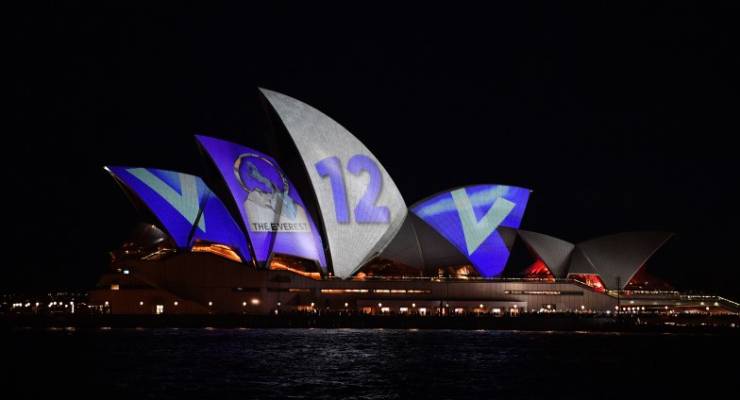
The Racing NSW projections on the Opera House sails earlier this month incited a surge of outrage among Sydneysiders. But the controversial decision, which enjoyed bipartisan political support, may not have even been legal.
The Opera House is world heritage listed. This means that under the Environmental Protection and Biodiversity Act, any action that has a significant impact on its outstanding universal value is an offence punishable by up to seven years in prison, unless the action is referred to and approved to the relevant minister by the Department of Energy and Environment.
But in an estimates hearing before the Senate Environment and Communications Legislation Committee on Monday night, the department said the controversial projection was never even considered for approval.
How is the department defending the decision?
Facing a barrage of questions from Greens Senator Sarah Hanson-Young, department representatives said approval was not considered because they did not believe the projections would have a significant impact on the building’s outstanding universal value.
“You can reasonably conclude that our assessment was that there was not a significant impact in prospect to the outstanding universal value in this instance,” Stephen Oxley, first assistant secretary to the department’s Heritage, Marine and Reef division said.
According to Dean Knudson, the department’s deputy secretary, the decision not to refer the projections was influenced by the fact that they were temporary, rather than ongoing.
“If we were dealing with an ongoing impact on the building, that’s a very different scenario from a one-time thing … if someone was proposing to paint the Opera House, that would be different”, Knudson said.
However Oxley admitted that the assessment might be different if advertising on the sails was ongoing.
While the Everest draw was a one-off event, it is not the first or last time the sails have been used for advertising. They have frequently been used to spruik Samsung, a major partner, in the past. And after Scott Morrison’s description of the building as “the biggest billboard we’ve got”, the draw may not be the last time the sails are commercialised. Taken together, however, cumulative instances of advertising could be viewed as significantly impacting the building’s heritage value, constituting an offence unless given ministerial approval.
What is meant by ‘hypothetical and subjective territory’?
Oxley also argued the question of whether the projections on the Opera House had a significant impact on the building’s outstanding universal value placed the department in “somewhat hypothetical and subjective territory”.
“The outstanding universal value is an aesthetic value … so there is a degree of subjectivity to how we would consider the extent to which outstanding universal value has been affected”, Oxley said.
However, the act also puts in place an approval process for any action likely to have a significant impact on the national heritage values of a national heritage place. Where the site is a national heritage place, rather than a world heritage place (the Opera House is both), the legislation creates a lower, less subjective threshold for triggering the approval requirements.
Importantly, the act indicates that whether an action has a “significant impact” is assessed with reference to the site’s particular national heritage values as prescribed on its own national heritage listing.
The Opera House’s specific national heritage listing makes explicit reference to the sails twice, underlining the importance of the “ceramic white tiles on the roof” and the “subtle floodlighting on the white roof shells at night”, which add to the building’s “dramatic aesthetic appeal”.
This means actions such as projecting advertisements onto the sails could potentially detract from these values as described in the list, therefore having a significant impact, and requiring ministerial approval. While the department’s relevant guidelines for when an action may cause significant impact are largely concerned with physical damage, they do also make reference to actions which “substantially alter a national heritage place in a manner inconsistent with its values”.
Once again, it is unclear whether the Everest debacle itself warranted a referral. But the consistent use of the Opera House as a billboard could require a referral and assessment.
A messy approval process
Ultimately, the department appears to have considerable discretion over whether an action is referred for approval. But the Opera House fiasco highlights the shortcomings of the legislative framework itself. The act is a poorly drafted, labyrinthine mess, making it easy for potentially more egregious misuses of heritage sites to slip through the cracks.
As Hanson-Young said in estimates, “what is the purpose of having these rules if you can just dodge them?”








It’s about intent.
A claim that Everest Broke the mandate to sustain the aesthetic of SOH’s white ceramic tiles isn’t a strong enough basis for an anti-Everest argument, since all other more artistic projections (like Vivid), would break the same law. Instead you’d have to base your pitch on motive, because therein lie not only the moral components in any projection, but also the reasons for the wide public protests we saw. Perhaps the idea of heritage is an essentially moral one anyway, because it’s based on respect.
One form of projection might be widely agreed as contributing to the social good, underpinned by qualities ranging from simple entertainment to the free imparting of spiritual gifts (depending on your understanding of art), whereas another, possessing qualities ranging from profit-maximisation to addiction-incitement and the preying upon society’s vulnerable (depending on your view of the Everest advertisement). The spirit of the rules must go to intent, which then goes to ethics, which is something a little less woolly or subjective than Mr Oxley tries to proclaim.
Art and advertising are distinguishable by intent. Next time, Everest, try art sponsorship if you can get away with it, it’s better PR.
I regard this episode as an example of the ‘slippery slope’ sequence of events. You start with Vivid, and proclaim that as OK, coz it’s Art, innit? And it’s once a year. Then you allow some sports advertising, coz sport should be as important as Art (provided it is participatory and not overtly commercialised). Then the next step is elite sports, which are heavily commercialised and now closely associated with gambling. Then you get to horse racing, whose primary purpose is to support gambling. And, as the article points out, the more you do it, the greater the possibility of transgressing that “universal values” criteria. Slippery Slope indeed.
Stephen Oxley is completely misinformed. The World Heritage Listing includes far more than its aesthetic values.
In the second sentence of the World Heritage inscription it states: “Its significance is based on its unparalleled design and construction; its exceptional engineering achievements and technological innovation and its position as a world-famous icon of architecture.” And further on: ” The building is a great artistic monument and an icon, accessible to society at large.” And again: “It represents multiple strands of creativity, both in architectural form and structural design, a great urban sculpture carefully set in a remarkable waterscape and a world famous iconic building.”
Surely these projections, even temporary, for mere promotion and advertising are nothing other than desecration and blatant disrespect of this world-famous icon. Would the Indian government contemplate advertising its latest Bollywood block-buster on the white marble exterior of the Taj Mahal – another World Heritage listed building and world-famous architectural icon? And would we regard that as desecration or disrespect?
The EPBC Act Significant Impact Criteria states: “An action is likely to have a significant impact on the World Heritage values of a declared World Heritage property if there is a real chance or possibility that it will cause:
• one or more of the World Heritage values to be lost
• one or more of the World Heritage values to be degraded or damaged, or
• one or more of the World Heritage values to be notably altered, modified, obscured or diminished.”
Similar criteria guide the assessment of significant impacts for National Heritage places.
Values ‘degraded’ or ‘diminished’..? Definitely YES.